「ダンケルクの奇跡:絶望の中での決断と救出劇」
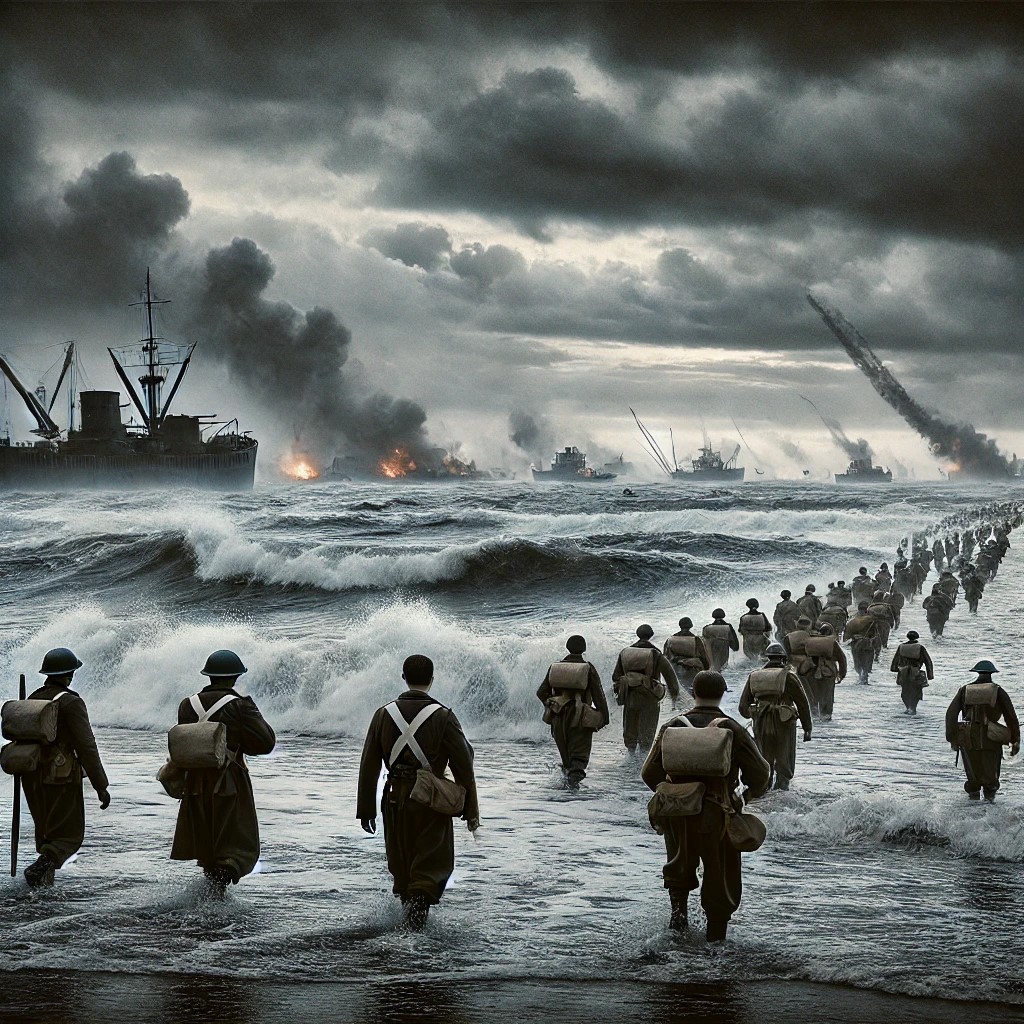
「1940年、フランスの海岸線で起こった一つの奇跡。戦争の最中、数十万の兵士たちが絶望の中で一筋の希望を見出しました。この奇跡の物語、ダンケルクの撤退作戦を紐解いていきましょう。」
「第二次世界大戦、ヨーロッパは暗雲に覆われ、全てが絶望に満ちていました。1940年、ドイツ軍は電撃戦でフランスに侵攻し、瞬く間に連合軍を追い詰めました。イギリス軍とフランス軍は後退を余儀なくされ、フランスの北端、ダンケルクという小さな港町へと追い込まれます。ここで、40万に及ぶ連合軍兵士がドイツ軍の猛攻を受けながらも、奇跡的に救出されることとなるのです。この『ダンケルクの奇跡』は、戦争の最も劇的なエピソードの一つとして語り継がれています。本ページでは、この歴史的な出来事の全貌と、それを取り巻く人間ドラマ、そして戦争の教訓を詳しくご紹介します。」
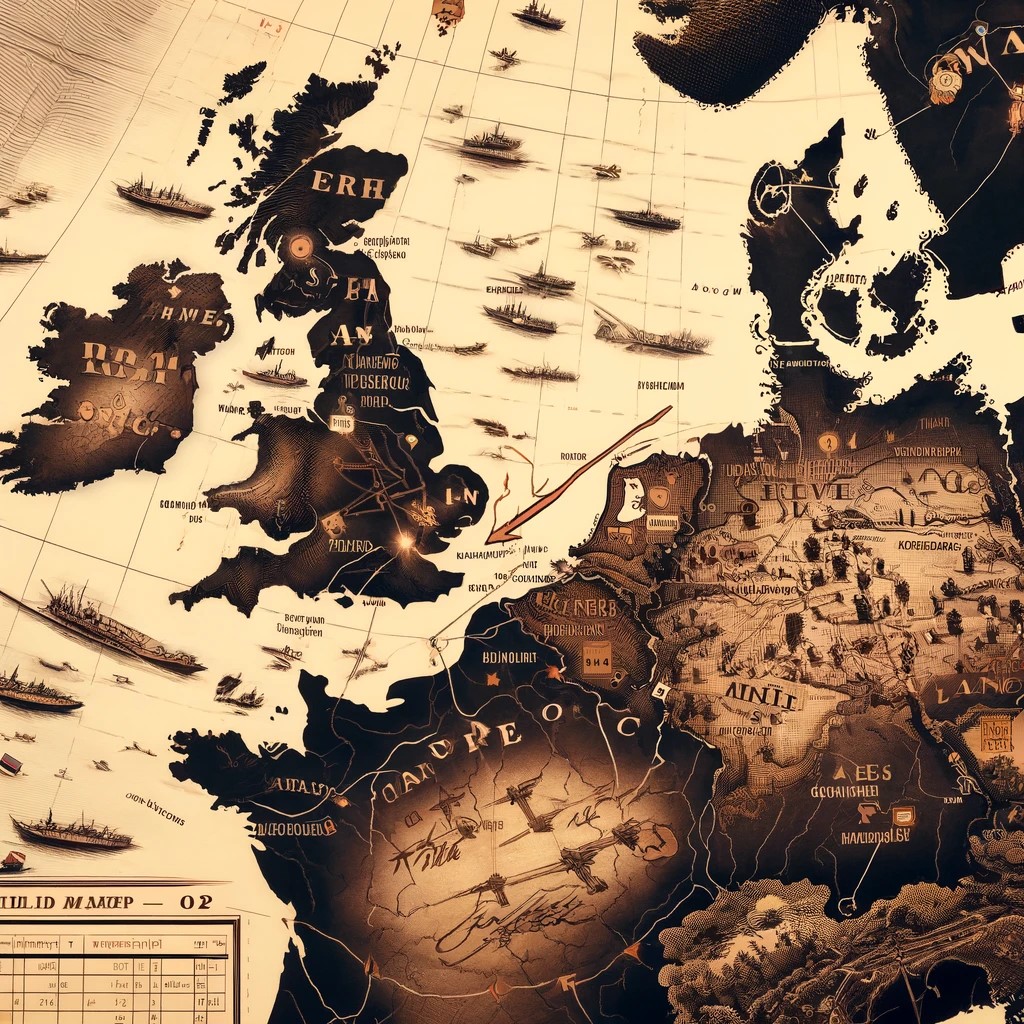
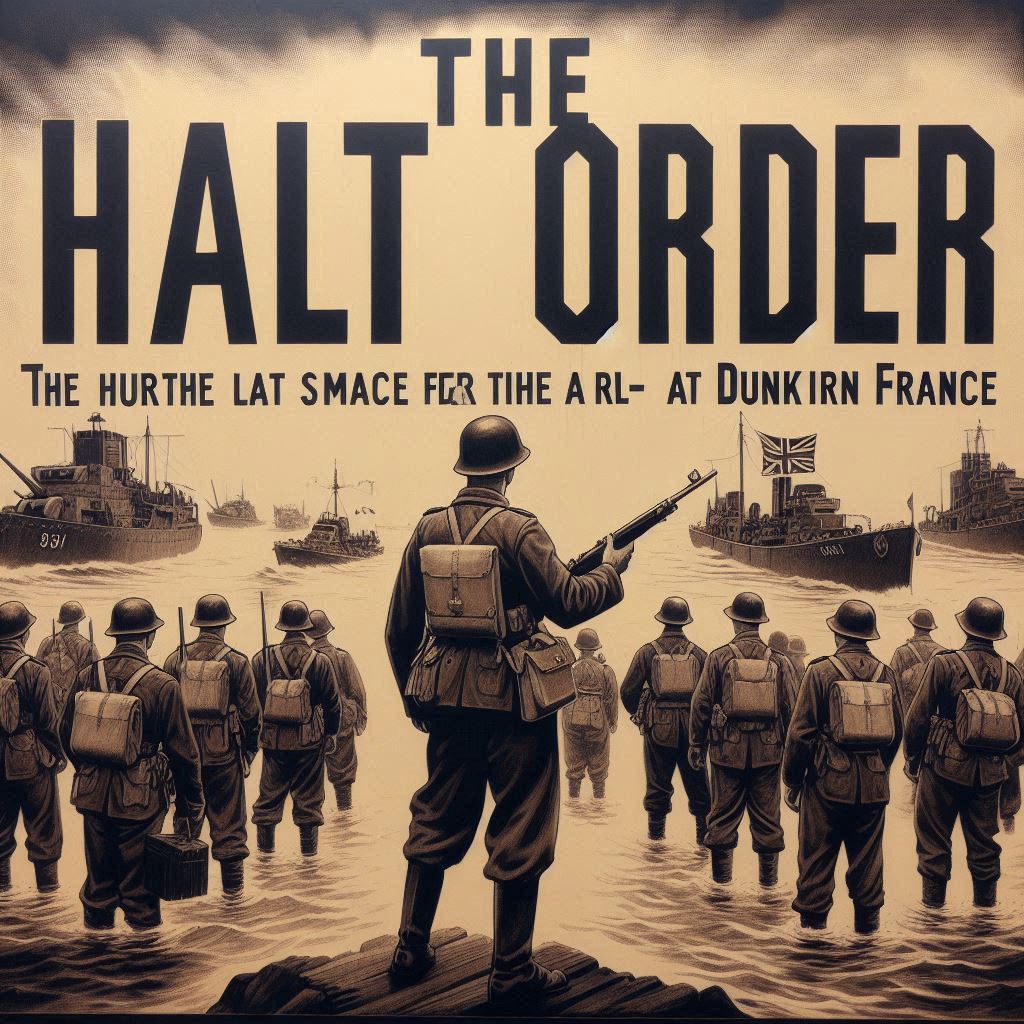
* 「第二次世界大戦が始まり、ドイツ軍は驚異的な速さでフランスに進撃しました。1940年5月、ナチス・ドイツは電撃戦(Blitzkrieg)と呼ばれる戦術で連合軍を圧倒し、フランス北部へと追い詰めました。連合軍はフランスのダンケルクに追い込まれ、包囲されることとなりました。フランスは急速に崩壊しつつありました。ドイツ軍の電撃戦は、計画された完璧な攻撃の連続であり、連合軍は瞬く間に後退を強いられました。フランス軍とイギリス遠征軍は、敵の進撃を食い止めることができず、ドイツ軍の圧倒的なスピードと戦術に打ちのめされました。ドイツ軍はアルデンヌの森を突破し、予想外の経路からフランスに侵入しました。連合軍は、この奇襲に対応する準備ができておらず、防御線は次々に崩壊していきました。フランス北部は次第にドイツ軍に占領され、連合軍は海岸線に向けて後退を余儀なくされました。彼らの唯一の逃げ道は、ダンケルクという小さな港町でした。しかし、この撤退が成功する可能性は極めて低く、状況はまさに絶望的でした。イギリス軍は、フランスを見捨てるという決断を余儀なくされ、ダンケルクでの撤退作戦を計画することとなります。」

「1940年5月、フランスの北端に位置するダンケルクのビーチには、約40万の連合軍兵士が取り残されていました。彼らはドイツ軍の急速な進撃により、フランス各地から追い詰められ、この狭い砂浜に集結しました。海は彼らの唯一の逃げ道でしたが、それはまた、ドイツ空軍による無慈悲な空襲の標的ともなりました。連日、上空にはドイツの戦闘機と爆撃機が飛び交い、兵士たちは絶え間ない攻撃にさらされました。彼らは堅牢な防御陣地もなく、海に向かってただじっと座り込み、もしくは穴を掘って身を潜めるしかありませんでした。爆発音が鳴り響く中、兵士たちは無力感に打ちひしがれ、次の指示を待つしかありませんでした。食料や弾薬は底をつき、恐怖と絶望が彼らの心を支配していました。生きて祖国に帰れるのか、それともこの地で命を落とすのか、彼らの運命はまだ決まっていなかったのです。」
* 「この絶望的な状況の中で、まさに奇妙な出来事が起こりました。ダンケルクを包囲していたドイツ軍が、突如として進撃を停止したのです。これが後に『ハルト・オーダー』と呼ばれる、ヒトラー自身が発した命令でした。この命令により、戦車部隊は3日間にわたって停止し、その間に連合軍はダンケルクからの撤退準備を進めることができたのです。しかし、この命令の背景にはいくつかの説があり、歴史家たちはいまだにその真意を探り続けています。
ある説によれば、ヒトラーはイギリスとの和平交渉を期待しており、ここでの攻撃を控えることで、イギリス側に譲歩の余地を与えようとしたのではないかと言われています。一方、別の説では、ドイツ軍の上層部が、地形的な制約や補給線の問題を考慮し、これ以上の進撃を避けるべきだと判断したのではないかとも考えられています。また、ヒトラーが空軍の指揮官ヘルマン・ゲーリングの提案に従い、空からの攻撃で連合軍を壊滅させることに自信を持っていたため、地上軍の進撃を止めたとも言われています。
この『ハルト・オーダー』の決断がなければ、ダンケルクでの撤退はおそらく成功しなかったでしょう。しかし、この不可解な停止命令が、戦争の流れを大きく変えることになったのです。後の歴史家たちは、この命令をめぐってさまざまな議論を繰り広げ、第二次世界大戦における最も重要な転換点の一つとして評価しています。謎に包まれたこの命令は、戦争の残酷さと同時に、偶然の要素がもたらす運命の不確かさをも象徴しています。」
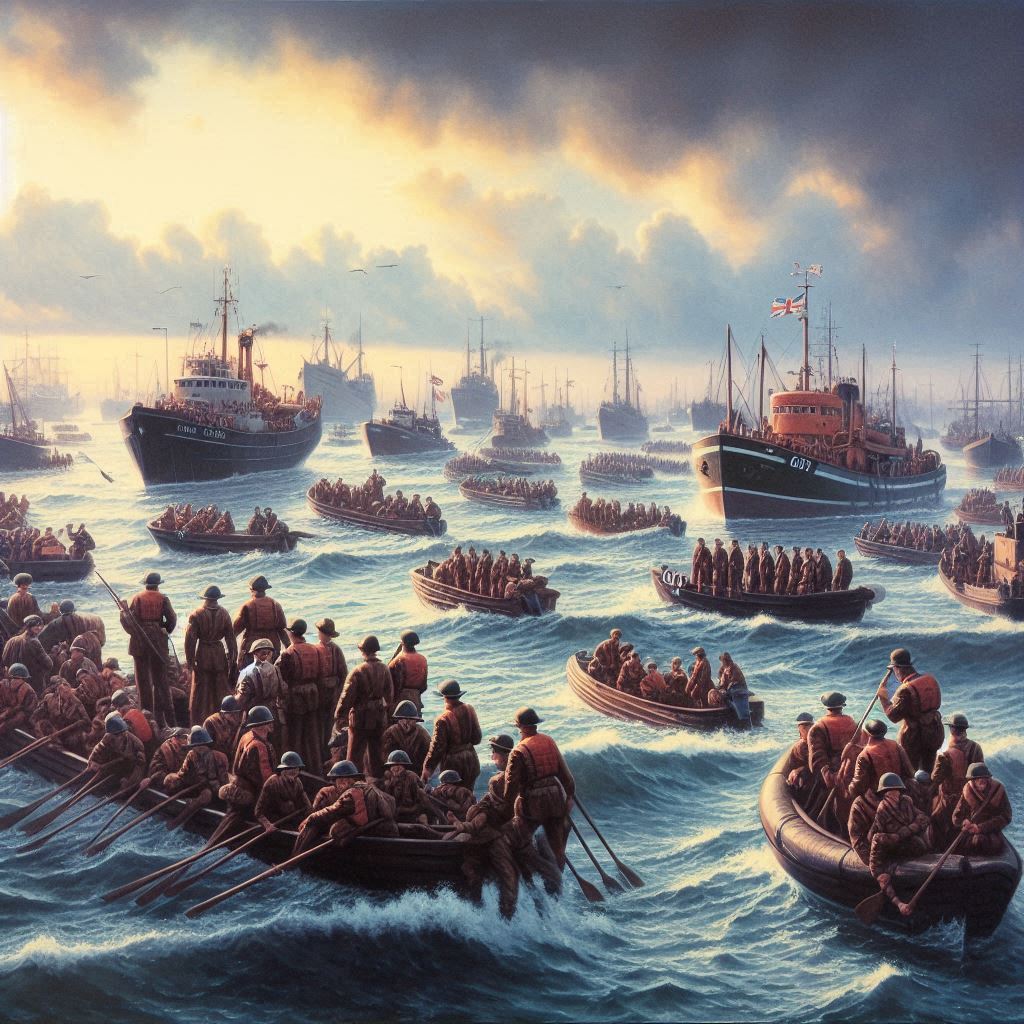
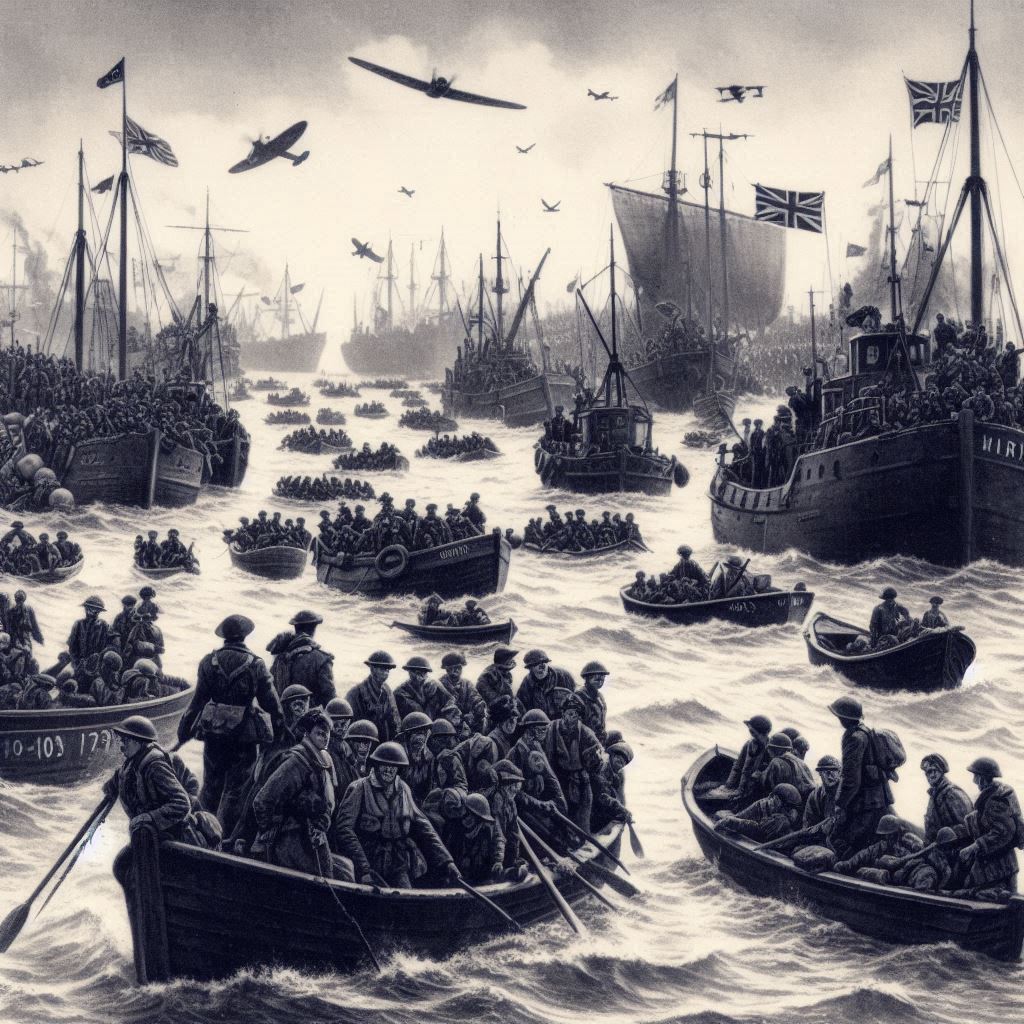
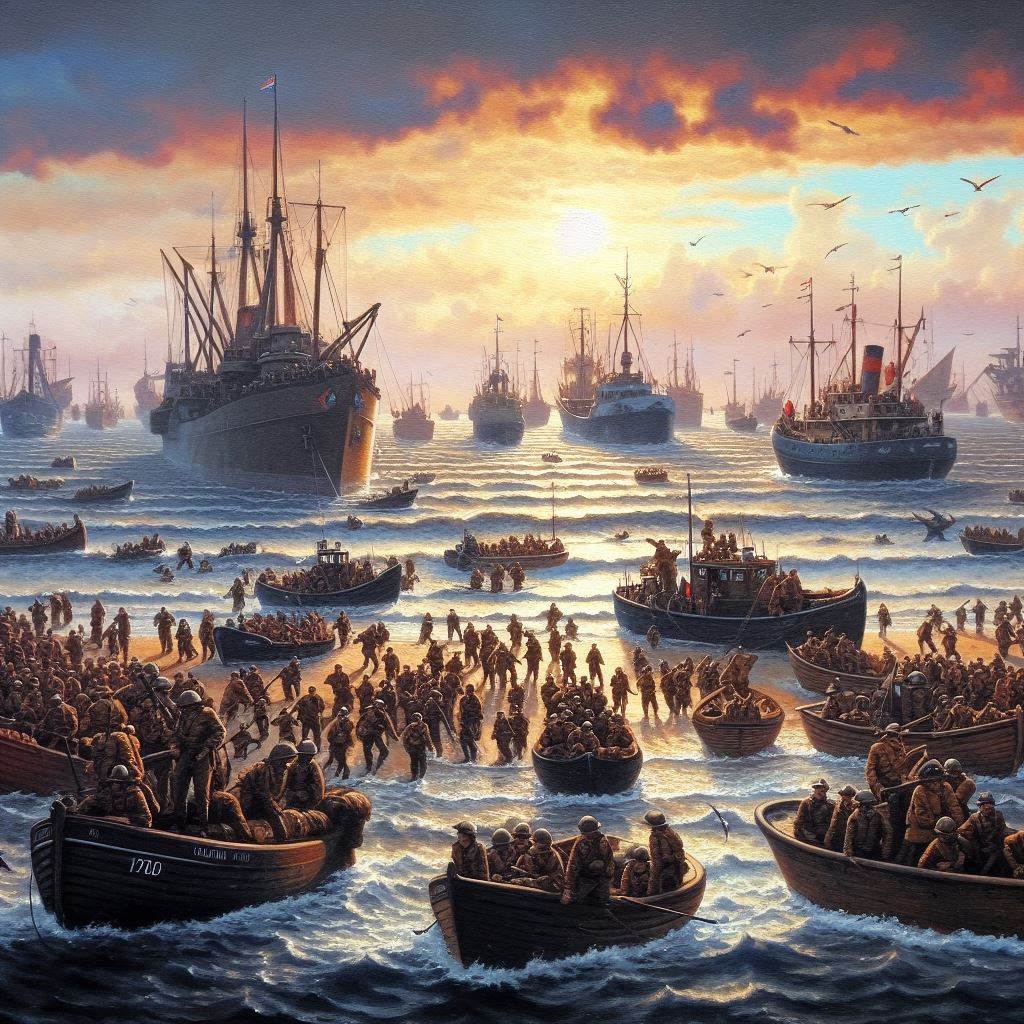
「しかし、絶望の中で、一筋の希望の光が差し込んできました。イギリスのウィンストン・チャーチル首相と軍の指導者たちは、兵士たちを救出するために大規模な撤退作戦を計画しました。その名も『ダイナモ作戦』。通常の軍艦だけでは足りないと判断されたため、イギリス中からあらゆる種類の船が動員されることになりました。漁師の小さなボートから豪華なヨット、古いタグボートまで、ありとあらゆる船が急遽召集されました。多くの船主たちは自ら船を操り、命を懸けて兵士たちを救出しようと決意しました。これらの船が、命を懸けて海峡を越え、ダンケルクに取り残された兵士たちを救出するために向かったのです。海上では、船員たちが波と風に立ち向かいながら、兵士たちを次々と救い出しました。彼らは何もかもを捨て、祖国のため、そして戦友たちのために海へと出航したのです。荒れる海と空襲の危険をものともせず、彼らは勇気を振り絞り、ダンケルクへ向かいました。彼らの目には、決意と誇りが宿っていました。彼らは知っていました。この作戦が成功するか否かが、連合軍の運命を左右することを。彼らの勇気と決意は、戦争の中で生まれた連帯感の象徴となりました。絶え間ない爆撃と砲撃にもかかわらず、彼らは恐れることなく進み続けました。このダイナモ作戦は、戦争の歴史において最も感動的な救出劇の一つとして、今も語り継がれています。」
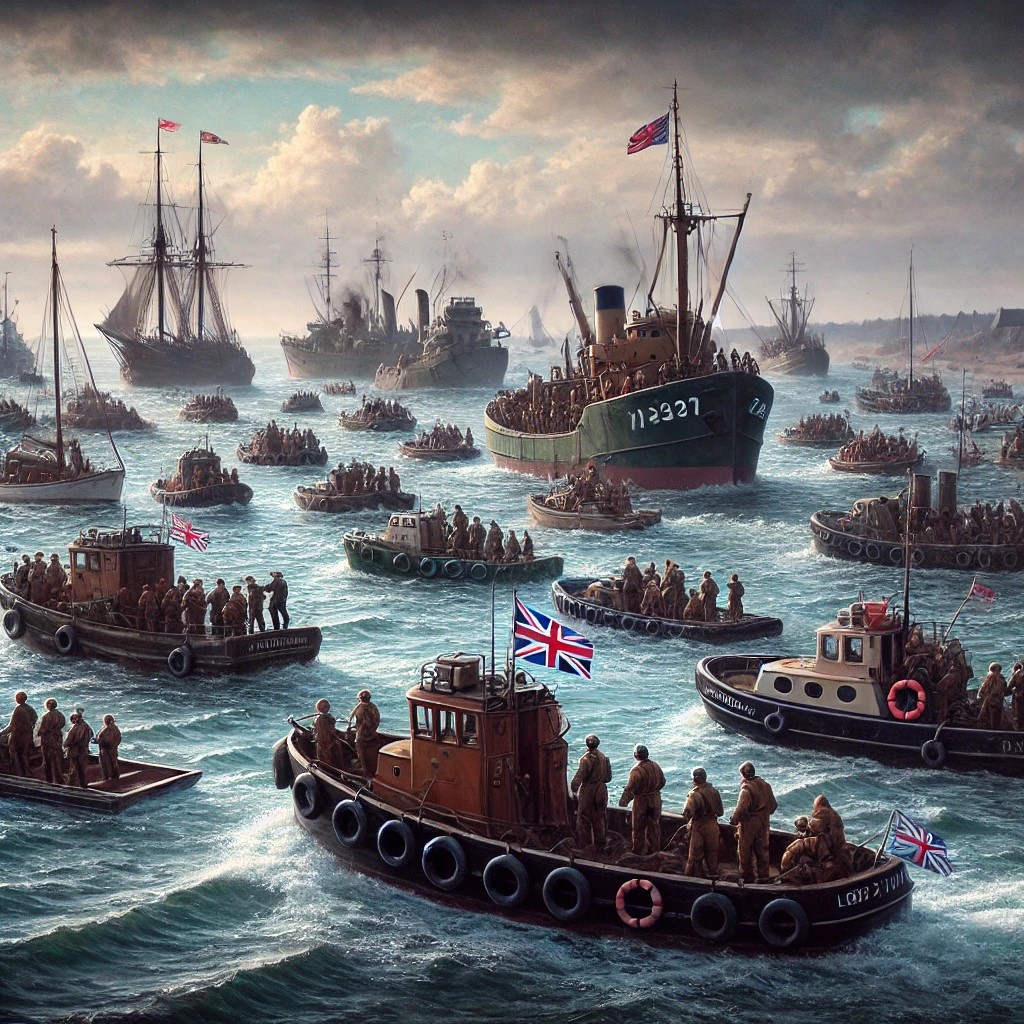
* 「わずか9日間で、約33万人もの兵士が海を渡り、イギリス本土へと無事に帰還しました。この撤退作戦は、奇跡としか言いようのないものでした。絶望の中で見出されたこの奇跡は、後に連合軍の士気を大きく高め、戦争の転換点の一つとなったのです。 10日間にわたる激しい戦闘と救出作戦の末、ついにダイナモ作戦は完遂されました。民間船と軍艦が力を合わせ、33万人以上の兵士が無事にイギリス本土へと帰還しました。彼らが港に着いた瞬間、人々は歓声を上げ、涙を流して出迎えました。しかし、その喜びの影には、失われた仲間たちの記憶が刻まれていました。ダンケルクのビーチには、多くの兵士が取り残され、また犠牲となったのです。それでも、この作戦の成功は、連合軍にとって大きな希望の光となり、イギリスの士気を高める結果となりました。帰還した兵士たちは、戦い続ける覚悟を新たにし、次なる戦場へと向かう準備を整えました。ダンケルクでの奇跡は、彼らの心に深く刻まれ、戦後も長く語り継がれることとなります。この救出劇は、ただの撤退ではなく、連合軍が再び立ち上がり、逆境に立ち向かう力を得た瞬間でもあったのです。」
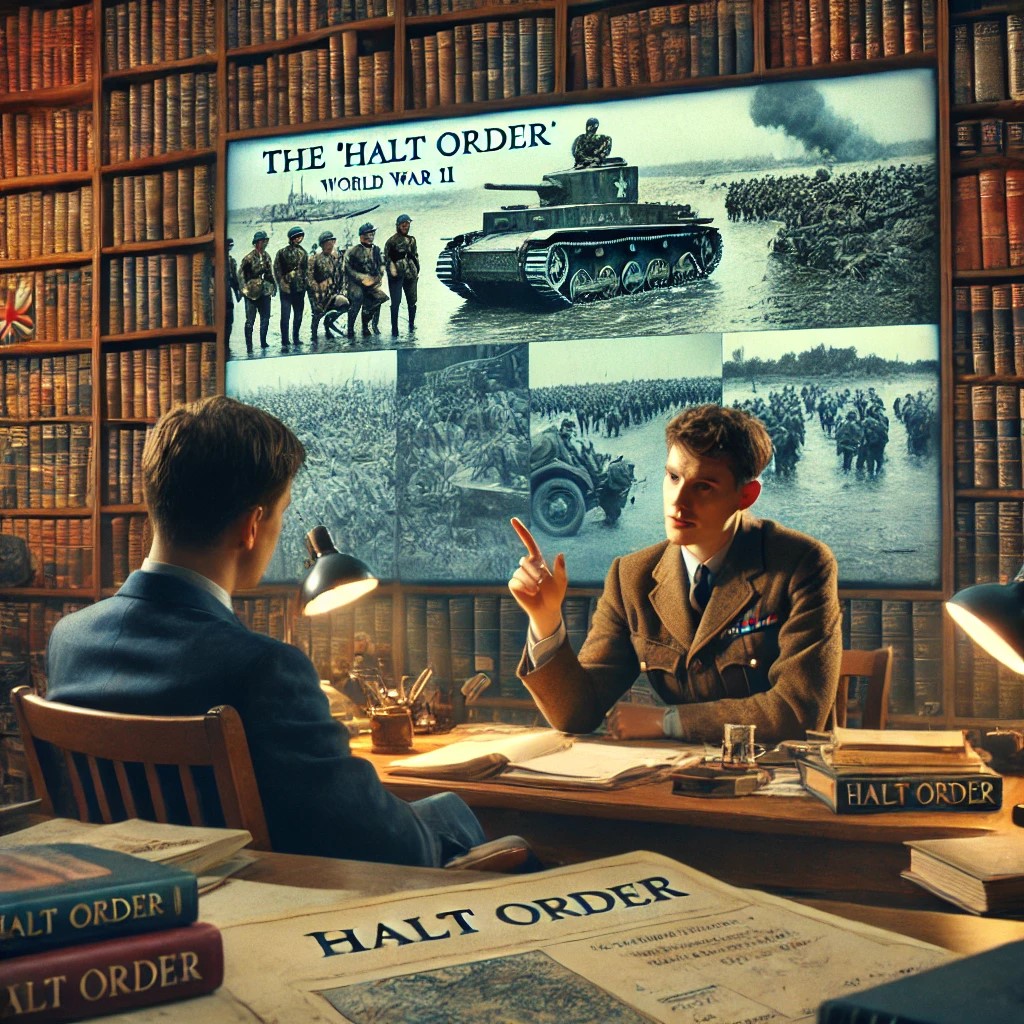
ドイツ軍がダンケルクを目前にしながら、進撃を突然止めた謎の命令、『ハルト・オーダー』。この決定は歴史上、最も不可解な軍事判断の一つとして議論され続けています。1940年5月24日、ドイツ軍の戦車部隊がダンケルクに迫り、連合軍を一気に壊滅させる寸前でした。しかし、ヒトラーと彼の指揮官たちは突如として攻撃を停止する命令を下しました。歴史家たちはこの決断の背後にある理由を様々に推測してきました。
ヒトラーがハルト・オーダーを出した理由については、いくつかの説がありますが、正確な理由は不明です。いくつかの理由として考えられているのは:
1. 地形の懸念: ダンケルク周辺の湿地や河川がドイツの戦車部隊の進撃を困難にするのではないかという懸念。
2. ルフトヴァッフェへの信頼: ヒトラーは空軍(ルフトヴァッフェ)が連合軍を壊滅できると信じていたため、陸軍の進撃を停止させた。
3. 政治的意図: ヒトラーは、イギリスと和平交渉を行うために、イギリス軍を完全に殲滅するのではなく、撤退させることで、交渉の材料にしようと考えた可能性。
4. 戦略的考慮: ドイツ軍が戦力を再編成し、補給線を整えるための時間を得るために停止命令が出された。
結果として、この命令により連合軍は撤退の時間を得て、約33万人の兵士が救出されました。ハルト・オーダーは、ドイツ軍が連合軍を完全に壊滅させる機会を逃した大きな誤りとして後世に記憶されています。また、この決定は結果的に連合軍にとって救いとなり、ダイナモ作戦の成功を可能にしたのです。この命令がなければ、ダンケルクでの救出劇は実現しなかったかもしれません。ハルト・オーダーは、戦争の行方を大きく変えた一つの重要な岐路であり、今なおその謎と影響が議論されています。」
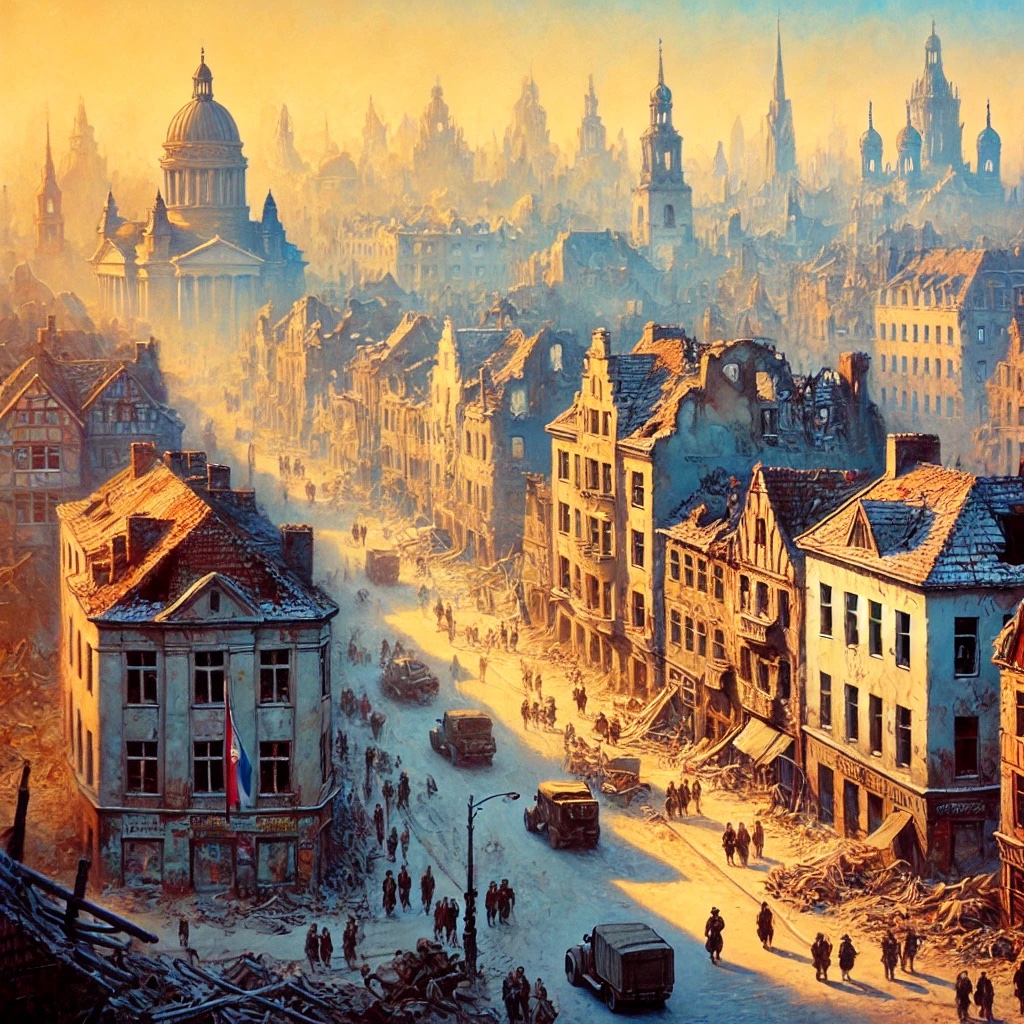
「ダンケルクの奇跡は、戦争の無慈悲さと同時に、人間の勇気と団結の力を示す出来事として歴史に刻まれました。戦後のヨーロッパは、その傷跡を癒すために必死に復興を進めました。戦火に焼かれた都市が再び立ち上がり、国々は新たな平和の時代を築こうと努力しました。瓦礫の中から新しい建物が建ち、かつて戦場となった場所には平和の象徴が立ち並びました。戦争を生き延びた人々は、家族と再会し、新しい生活を築き上げました。しかし、彼らの心には決して消えることのない記憶が刻まれていました。戦争の恐怖、失われた友人や家族のこと、そして自分たちが生き延びた奇跡。彼らは、同じ過ちを二度と繰り返さないようにと誓いました。ダンケルクの奇跡は、私たちに戦争の教訓を教えてくれます。それは、困難な状況においても希望を失わず、共に立ち上がることの大切さ、そして平和の尊さを決して忘れてはならないということです。」
The Miracle of Dunkirk: Decisions Made in the Depths of Despair

In 1940, a miracle unfolded on the shores of France. In the midst of war, hundreds of thousands of soldiers found a glimmer of hope in the depths of despair. Let us unravel the story of this miraculous event ? the Dunkirk evacuation.
During World War II, Europe was shrouded in darkness, filled with despair. In 1940, the German army launched a blitzkrieg into France, swiftly driving the Allied forces into a corner. The British and French troops were forced to retreat, eventually becoming trapped in the small port town of Dunkirk, located in the northernmost part of France. There, nearly 400,000 Allied soldiers faced relentless German attacks ? yet, against all odds, they were miraculously rescued. This “Miracle of Dunkirk” remains one of the most dramatic episodes of the war. On this page, we will explore the full story of this historic event, the human drama surrounding it, and the profound lessons it offers about the nature of war.


As World War II began, the German army advanced into France with astonishing speed. In May 1940, Nazi Germany overwhelmed the Allied forces using a tactic known as Blitzkrieg, driving them into northern France. The Allies were pushed back and surrounded in the town of Dunkirk. France was rapidly collapsing.
The German Blitzkrieg was a series of meticulously planned attacks, and the Allied forces were quickly forced into retreat. The French army and the British Expeditionary Force were unable to halt the enemy’s advance, crushed by the sheer speed and precision of the German tactics. The Germans broke through the Ardennes Forest, entering France from an unexpected route. The Allies were unprepared for this surprise attack, and their defensive lines crumbled one after another.
Northern France gradually fell under German occupation, and the Allied forces were pushed back toward the coast. Their only route of escape was the small port town of Dunkirk. However, the chances of a successful evacuation were extremely slim, and the situation was utterly desperate. The British were forced to make the difficult decision to abandon France and began planning the evacuation operation at Dunkirk.

In May 1940, on the beaches of Dunkirk, located at the northern tip of France, nearly 400,000 Allied soldiers were left stranded. Driven back by the rapid advance of the German army, they had been forced from various parts of France and cornered onto this narrow stretch of sand. The sea was their only escape route?but it was also a prime target for relentless air raids by the German Luftwaffe.
Day after day, German fighters and bombers roared through the skies, subjecting the soldiers to constant attacks. With no solid defensive positions, they had no choice but to sit silently facing the sea or dig shallow holes in the sand to take cover. Amid the deafening sounds of explosions, the soldiers were overwhelmed by a sense of helplessness, left with nothing to do but wait for further orders. Supplies of food and ammunition were running out, and fear and despair took hold of their hearts. Would they return home alive, or perish on this very beach? Their fate remained uncertain.
Amid this desperate situation, a strange turn of events occurred. The German forces surrounding Dunkirk suddenly halted their advance. This would later become known as the “Halt Order,” a command issued directly by Hitler himself. As a result, German tank divisions were ordered to stop for three days, during which the Allied forces were able to prepare for evacuation from Dunkirk.
The reasons behind this order remain debated among historians to this day. One theory suggests that Hitler hoped for peace negotiations with Britain and refrained from pressing the attack to leave room for diplomatic concessions. Another theory posits that the German high command, facing logistical challenges and difficult terrain, advised against further advancement.
Additionally, some believe Hitler followed the advice of Luftwaffe commander Hermann Goring, who was confident that air power alone could annihilate the Allied troops.
Without the “Halt Order,” the evacuation at Dunkirk would likely have ended in disaster. Yet, this perplexing decision dramatically altered the course of the war. Later historians have engaged in ongoing debates over the meaning and consequences of this command, recognizing it as one of the most significant turning points in World War II. Shrouded in mystery, the order serves as a symbol not only of the brutality of war but also of the unpredictability of fate shaped by chance and circumstance.



Yet, in the depths of despair, a ray of hope began to shine. British Prime Minister Winston Churchill and military leaders devised a massive evacuation plan to rescue the stranded soldiers. This plan was called "Operation Dynamo."
Realizing that naval warships alone would not suffice, the British government mobilized every type of vessel from across the country. From small fishing boats to luxurious yachts and aging tugboats, all manner of ships were hastily summoned. Many civilian boat owners chose to sail their own vessels, risking their lives in a courageous effort to save the soldiers. These boats braved the perilous journey across the Channel, heading toward Dunkirk to rescue those left behind.
At sea, sailors battled waves and wind, pulling soldier after soldier from the beaches. They abandoned everything?sailing for their country, and for their fellow men. Undeterred by the stormy seas and the constant threat of air raids, they summoned all their courage and pressed on toward Dunkirk. Determination and pride filled their eyes, for they knew: the success or failure of this operation would determine the fate of the Allied forces.
Their bravery and resolve became a powerful symbol of unity forged in the crucible of war. Despite relentless bombings and shellfire, they pressed forward without fear. Operation Dynamo remains one of the most moving rescue missions in the history of warfare, remembered to this day for the extraordinary courage and solidarity it inspired.

In just nine days, approximately 330,000 soldiers crossed the sea and safely returned to the British mainland. This evacuation operation was nothing short of a miracle. Found in the depths of despair, this miracle would later become a major boost to Allied morale and a crucial turning point in the war.
After ten days of intense fighting and daring rescues, Operation Dynamo was finally completed. Civilian vessels and military ships worked together to bring over 330,000 soldiers safely back to Britain. When they arrived at port, people welcomed them with cheers and tears. Yet behind the joy lay the painful memory of those who were left behind. Many soldiers had been stranded or lost on the beaches of Dunkirk.
Even so, the success of this operation became a powerful beacon of hope for the Allies and greatly lifted British morale. The returning soldiers renewed their resolve to keep fighting and began preparing for the next battlefield. The miracle of Dunkirk left a deep mark on their hearts and would be remembered for generations to come.
This rescue was not merely a retreat?it was the moment the Allied forces stood back up and found the strength to face adversity once again.

The mysterious order known as the “Halt Order,” in which the German army suddenly stopped its advance just short of Dunkirk, remains one of the most puzzling military decisions in history. On May 24, 1940, German armored divisions were closing in on Dunkirk, on the verge of annihilating the Allied forces. Yet, Hitler and his commanders abruptly issued an order to halt the attack. Historians have long speculated about the reasons behind this decision.
While the exact motivation for Hitler's Halt Order remains unclear, several theories have been proposed:
Concerns about the terrain: The marshes and rivers surrounding Dunkirk may have been seen as obstacles that would hinder the movement of German tanks.
Trust in the Luftwaffe: Hitler may have believed that the Luftwaffe (German air force) could destroy the Allied forces from the air, making a ground assault unnecessary.
Political motives: It is possible that Hitler hoped to negotiate peace with Britain, and by allowing their forces to retreat rather than annihilating them, he aimed to use this as leverage in potential talks.
Strategic considerations: The halt may have been intended to give German forces time to reorganize, rest, and secure their supply lines before continuing the offensive.
As a result of this order, the Allies gained the critical time needed to evacuate approximately 330,000 soldiers. The Halt Order is now remembered as a major missed opportunity for the German army to completely crush the Allied forces. At the same time, it became a saving grace for the Allies, enabling the success of Operation Dynamo. Without this command, the dramatic rescue at Dunkirk might never have happened.
The Halt Order stands as a key turning point in the war, and its mystery and consequences continue to be the subject of historical debate to this day.

The Miracle of Dunkirk is etched into history not only as a testament to the cruelty of war, but also as a shining example of human courage and unity. In the aftermath of the war, Europe desperately sought to heal its wounds and rebuild. Cities that had been reduced to ashes began to rise again, and nations worked tirelessly to usher in a new era of peace. From the rubble, new buildings were constructed, and symbols of peace stood where battlefields once lay.
Those who survived the war were reunited with their families and began to build new lives. Yet, within their hearts remained memories that would never fade?the horrors of war, the friends and family they had lost, and the miracle that allowed them to survive. They vowed never to repeat the same mistakes again.
The Miracle of Dunkirk teaches us powerful lessons about war. It reminds us that even in the darkest of times, we must not lose hope; that we must stand together; and above all, that the value of peace must never be forgotten.
